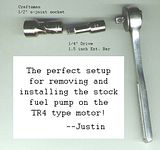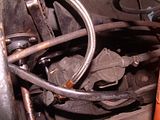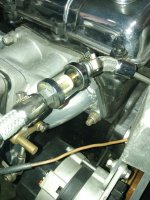OP
TexasKnucklehead
Jedi Knight
Offline
So a fellow club member loaned me his original AC fuel pump that he removed under suspicion of an oil leak. After I installed it, and made a new cork gasket for the bowl, I tested it by running the engine until the temperature was normal, then shutting it off, closed the hood and let it sit for 5 minutes. I also changed out the filter element. Here is how the AC pump performs on the warmed engine: https://youtu.be/QgvrkYOxTlQ The next time anyone tells me 'there's so much room under the hood, it must be easy to work on', I will know that person never changed a fuel pump on a TR3 while the engine was in the car.
I don't think either fuel pump is bad. I don't think the invisible fuel in my filter is a problem. -But I still don't know what to think.
While I was changing the pump, I removed the vice grips that were used as a clamp on the fuel line from the tank to be sure a constant stream of fuel was available by gravity. My old fuel pump glass bowl had a little debris in it, but nothing serious. The in-line filter also showed some signs of working, but not enough to clog it.
I don't think either fuel pump is bad. I don't think the invisible fuel in my filter is a problem. -But I still don't know what to think.
While I was changing the pump, I removed the vice grips that were used as a clamp on the fuel line from the tank to be sure a constant stream of fuel was available by gravity. My old fuel pump glass bowl had a little debris in it, but nothing serious. The in-line filter also showed some signs of working, but not enough to clog it.

 Hi Guest!
Hi Guest!

 smilie in place of the real @
smilie in place of the real @
 Pretty Please - add it to our Events forum(s) and add to the calendar! >>
Pretty Please - add it to our Events forum(s) and add to the calendar! >> 




